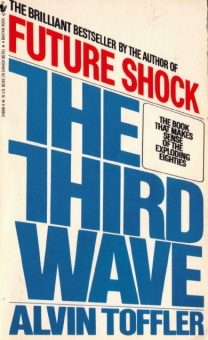THE THIRD WAVE
The resultant Constitution of 1787 was an ingenious compromise. Because First Wave forces were still strong, the Constitution reserved important powers to the states rather than the central government. To prevent overly strong central power it also called for a unique separation of legislative, executive, and judicial powers. But the Constitution also contained elastic language that would eventually permit the federal government to extend its reach drastically.
As industrialization pushed the political system toward greater centralization, the government in Washington took on an increasing number of powers and responsibilities and monopolized more and more decision-making at the center. Within the federal government, meanwhile, power shifted from Congress and the courts to the most centralist of three branches—the Executive. By the Nixon years, historian Arthur Schlesinger (himself once an ardent centralizer) was attacking the “imperial presidency.”
The pressures toward political centralization were even stronger outside the United States. A quick look at Sweden, Japan, Britain, or France is enough to make the U.S. system seem decentralized by comparison. Jean-Franc.ois Revel, au* thor of Without Marx or Jesus, makes this point in describing how governments respond to political protest: “When a demonstration is forbidden in France, there is never any doubt about the source of the prohibition. If it is a question of a major political demonstration, it is the [central] government,” he says. “In the United States, however, when a demonstration is forbidden, the
first question everyone asks is, ‘By whom?'” Revel points out that it is usually some local authority operating autonomously.
The extremes of political centralization were found, of course, in the Marxist industrial nations. In 1850 Marx called for a “decisive centralization of power in the hands of the state.” Engels, like Hamilton before him, attacked decentralized confederations as “an enormous step backward.” Later on the Soviets, eager to accelerate industrialization, proceeded to construct the most highly centralized political and economic structure of all, submitting even the smallest of production decisions to the control of central planners.
59
Pages: 1 2 3 4 5 6 7 8 9 10 11 12 13 14 15 16 17 18 19 20 21 22 23 24 25 26 27 28 29 30 31 32 33 34 35 36 37 38 39 40 41 42 43 44 45 46 47 48 49 50 51 52 53 54 55 56 57 58 59 60 61 62 63 64 65 66 67 68 69 70 71 72 73 74 75 76 77 78 79 80 81 82 83 84 85 86 87 88 89 90 91 92 93 94 95 96 97 98 99 100 101 102 103 104 105 106 107 108 109 110 111 112 113 114 115 116 117 118 119 120 121 122 123 124 125 126 127 128 129 130 131 132 133 134 135 136 137 138 139 140 141 142 143 144 145 146 147 148 149 150 151 152 153 154 155 156 157 158 159 160 161 162 163 164 165 166 167 168 169 170 171 172 173 174 175 176 177 178 179 180 181 182 183 184 185 186 187 188 189 190 191 192 193 194 195 196 197 198 199 200 201 202 203 204 205 206 207 208 209 210 211 212 213 214 215 216 217 218 219 220 221 222 223 224 225 226 227 228 229 230 231 232 233 234 235 236 237 238 239 240 241 242 243 244 245 246 247 248 249 250 251 252 253 254 255 256 257 258 259 260 261 262 263 264 265 266 267 268 269 270 271 272 273 274 275 276 277 278 279 280 281 282 283 284 285 286 287 288 289 290 291 292 293 294 295 296 297 298 299 300 301 302 303 304 305 306 307 308 309 310 311 312 313 314 315 316 317 318 319 320 321 322 323 324 325 326 327 328 329 330 331 332 333 334 335 336 337 338 339 340 341 342 343 344 345 346 347 348 349 350 351 352 353 354 355 356 357 358 359 360 361 362 363 364 365 366 367 368 369 370 371 372 373 374 375 376 377 378 379 380 381 382 383 384 385 386 387 388 389 390 391 392 393 394 395 396 397 398 399 400 401 402 403 404 405 406 407 408 409 410 411 412 413 414 415 416 417 418 419 420 421 422 423 424 425 426 427 428 429 430




